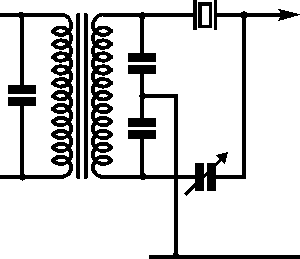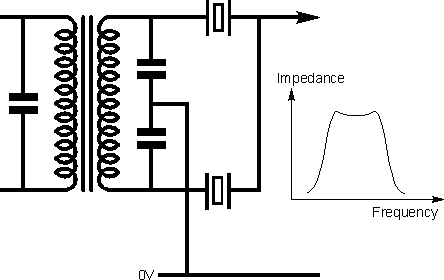Quartz crystal band pass filters
- summary, overview or tutorial about the basics of the different types of
crystal filter that can be used in radio communications receivers including the
single crystal filter, half lattice crystal filter, and the ladder crystal
filter.
Crystal filters are widely used in many applications
including radio receivers as well as many other radio communications
applications. The very high level of Q makes the quartz crystal resonators they
use makes them ideal for use as the primary band pass RF filter in high
performance radio communications receivers. As a result of this there are a
number of circuits that have been used to provide the required level of
selectivity and performance over the years. These include the single crystal
filter, the half lattice crystal filter and the ladder filter.
Single crystal filter
The simplest crystal filter employs a single crystal. This
type of RF filter was developed in the 1930s and was used in early receivers
dating from before the 1960s but is rarely used today. Although it employs the
very high Q of the crystal, its response is asymmetric and it is too narrow for
most applications, having a bandwidth of a hundred Hz or less.
In the circuit there is a variable capacitor that is used to
compensate for the parasitic capacitance in the crystal. This capacitor was
normally included as a front panel control.

Diagram of filter using a single quartz crystal
Half lattice crystal filter
This form of band pass RF filter provided a significant
improvement in performance over the single. In this configuration the parasitic
capacitances of each of the crystals cancel each other out and enable the
circuit to operate satisfactorily. By adopting a slightly different frequency
for the crystals, a wider bandwidth is obtained. However the slope response
outside the required pass band falls away quickly, enabling high levels of out
of band rejection to be obtained. Typically the parallel resonant frequency of
one crystal is designed to be equal to the series resonant frequency of the
other.
Despite the fact that the half lattice crystal filter can
offer a much flatter in-band response there is still some ripple. This results
from the fact that the two crystals have different resonant frequencies. The
response has a small peak at either side of the centre frequency and a small dip
in the middle. As a rough rule of thumb it is found that the 3 dB bandwidth of
the RF filter is about 1.5 times the frequency difference between the two
resonant frequencies. It is also found that for optimum performance the matching
of the filter is very important. To achieve this, matching resistors are often
placed on the input and output. If the filter is not properly matched then it is
found that there will be more in-band ripple and the ultimate rejection may not
be as good.

Diagram of half lattice crystal filter
A two pole filter (i.e. one with two crystals) is not
normally adequate to meet many requirements. The shape factor can be greatly
improved by adding further sections. Typically ultimate rejections of 70 dB and
more are required in a receiver. As a rough guide a two pole filter will
generally give a rejection of around 20 dB; a four pole filter, 50 dB; a six
pole filter, 70 dB; and an eight pole one 90 dB.
Crystal ladder filter
For many years the half lattice filter was possibly the most
popular format used for crystal filters. More recently the ladder topology has
gained considerable acceptance. In this form of crystal pass band filter all the
resonators have the same frequency, and the inter-resonator coupling is provided
by the capacitors placed between the resonators with the other termination
connected to earth.

Four pole ladder crystal filter
Summary
Crystal filters are widely used in many radio communications
receiver applications. Here these filters are able to provide very high levels
of performance and at a cost which is very reasonable for the performance that
is given. These RF filters may be made in a variety of formats according to the
applications and the performance needed. While these RF filters can be made from
discrete components, ready manufactured crystal filters are normally bought,
either off the shelf, of made to a given specification.
|

